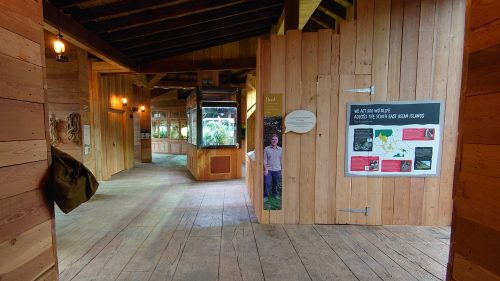In 2015, Islands opened to the public. A £40 million project, 60,000 square meters, orangutans, tigers, crocodiles and countless unique plants, it was designed to be our first geographically themed immersive environment, taking visitors on a journey across six South East Asian islands.
With Monsoon Forest at the heart, the jewel in the crown, and also the UK’s largest indoor zoo habitat, this immersive habitat was an exercise in what progressive zoos should strive for.
But at the end of 2018, Monsoon Forest fell victim to a fire, causing a lot of damage to this amazing exhibition. What followed has been to a two-year long project to re-imagine the space, re-telling the stories that first captivated our visitors’ imaginations.
The origin of (Islands) Exhibits
Fred Howat, our Exhibitions and Interpretation Manager fills us in on the work that has taken place to help bring the stories of South East Asian Islands alive:
“I joined the Exhibitions and Interpretation team at the zoo in 2014, bringing together the story and interpretive elements of Islands. As a team we’re responsible for creating the narrative that connects audiences to our species and the work we do, through interventions such as signage, audio and visual elements, interactives, theming and habitat immersion. Islands was to be an exploration for visitors, following in the footsteps of Chester Zoo conservationists, transporting them to various islands in one of our core regions of work.
“The interpretation scheme was designed to work alongside the physical theming and planting, blending into the surroundings allowing our visitors to discover exciting details of our species and work. Visitors explored the Tripa Research station, finding hand-written notes from conservationists, spotting signs of the species they’d seen, exploring a rainforest amongst free-flying birds.
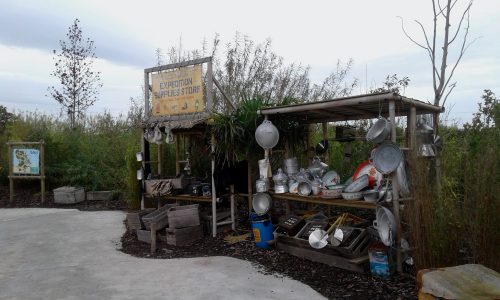
“In theory this concept married the overall narrative well, ensuring signage didn’t jar with the visitor experience. Audio and visual elements were authentic to the space and we wanted our signs to be part of the natural environment to add to this authenticity. It was something we’d not tried before, and was often referred to as ‘learning through osmosis’. But quite quickly, we discovered that it didn’t work as expected.
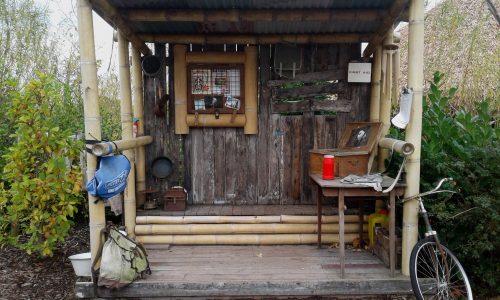
Evaluation as a means to progression
Through evaluation however, it became clear that much of the scheme was too covert, blending too well into the surroundings. This led to a year-long programme to reinterpret Islands, including Monsoon Forest, working within the parameters of what could be achieved on a live site.
Our new approach was clearer, more didactic, and focused on the individuals and teams carrying out vital conservation work. Our works were finally completed in November 2018. But only a month later, a fire caught hold, destroying large swathes of the building and displacing many species inside. And so too, the interpretation scheme was lost, either as a direct result of fire damage, or through a sharp shift in how’d we’d need to re-tell those stories.
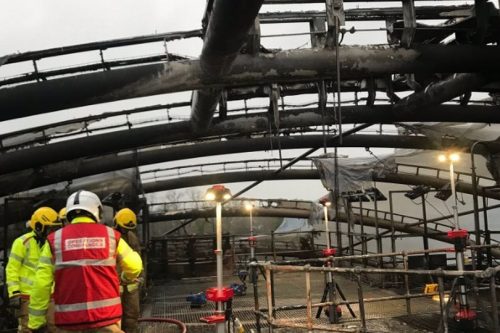
When the debris was finally cleared, and the loss fully understood, rebuilding Monsoon Forest began. And so we started the process again, seeking opportunities to learn from our findings and design an interpretation scheme that met new objectives, but new challenges too.
The re-interpretation process
While a tragedy, rebuilding the space provided each team, including the Exhibitions and Interpretation team, the chance to build on the lessons learnt, and to enhance the space beyond its original design. An outpouring of public donations created exciting additional opportunities, allowing us to design interventions that went beyond the insurer’s ‘like-for-like’ payment. Once we’d established our final budget, we could start applying our existing knowledge of the space, its objectives, our visitors’ experience and our storyline, and start creating the new scheme throughout Monsoon Forest.
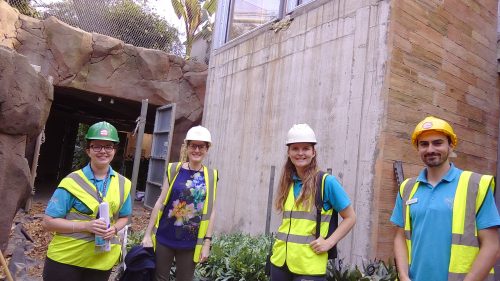
Core concepts
From the outset, we established some core primary objectives around which our scheme would sit. These were to:
- Compliment the overall story of Islands, leading visitors on an authentic and immersive journey through the habitat.
- Shine a spotlight on the people and projects behind conservation, those of Chester Zoo staff and our vital project partners.
- Connect and captivate visitors to the unique species of the South East Asian Islands, particularly our insects, fish, amphibians and reptile collection.

Challenges to consider
Creating the exhibition still took many months, particularly as it involved insurers, animal teams, build teams and a variety of other stakeholders. To complicate matters, a significant proportion of our works coincided with the outbreak of Covid-19, which included extended periods of furlough. And beyond those complications, it involved many common challenges that such projects experience, each requiring a methodical process to work through. Particular challenges included:
Through our primary objectives, we were able to work through many of these challenges, as they provides us solid justifications for the actions we took. And as we navigated each complication, our interpretation scheme started to take shape.
A narrative overview
Our scheme throughout Monsoon Forest was designed to be light on interpretation, allowing visitors to explore the space as a natural habitat. Our core area of focus became the Tripa Research Station, where as a ‘lived-in’ station, interpretation of our people and projects worked within the wider narrative of Islands.
In the space, we created several key strands to the story. An overview of our main conservation projects, an exploration of in-situ and ex-situ species management and a closer look at community engagement; each told through the voice of a member of staff. This followed the overall narrative of Islands, with visitors exploring our work by engaging with the individuals and teams doing it. It also allowed us to demonstrate how each strand of our work makes up one small part of a greater objective and that our holistic approach to conservation transpires through each project we work on.
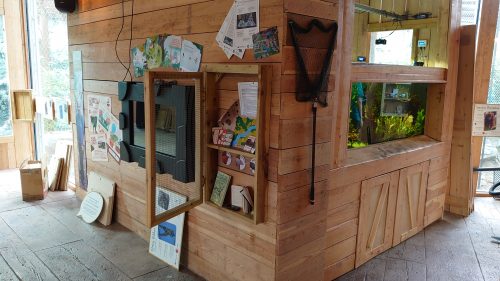
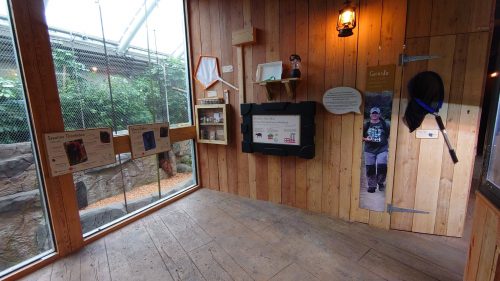
A focus on Community Engagement
One area that works particularly well is our spotlight on the work that the Conservation Education and Engagement team do in the South East Asian Islands. Here, various resources, banners and artworks are displayed across a wall, introduced by the Community Engagement Manager and supplemented by additional interpretation describing some of the projects. A digital touchscreen, designed to look ‘ruggedized’ for use in a forest, will eventually provide additional movement and sound into the dynamic.
This Covid-safe feature provides a unique snapshot of some community engagement methods, and helps add colour and depth to the area. It was also designed with visitor flow in mind, being accessible to visitors walking past but also those wanting to engage more deeply with it.
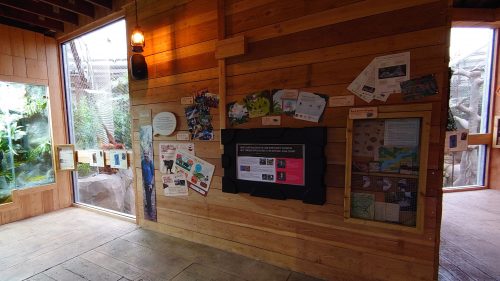
Looking forward: the future of Monsoon Forest
In time, as our conservation projects develop, the exhibitions and interpretation in Monsoon Forest will be developed further, ensuring visitors are provided with the most up-to-date stories and conservation efforts. It’s also vital for the stories we tell to remain relevant to our visitors and that we engage and empower them to take action in their own lives.
Having access to habitats that transport audiences into such immersive environments provides us with unique opportunities to captivate them in far deeper, more meaningful ways. It’s important we continue learning exactly how this type of engagement works, so we can continue to create exciting and inspirational spaces for our visitors. Despite the adversity faced with projects like this, the lessons we learn provide invaluable experience going forward and build upon our growing knowledge of what truly makes spaces like this so special.
